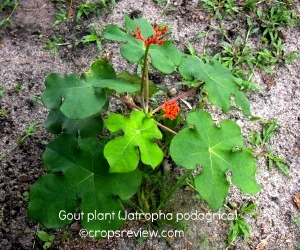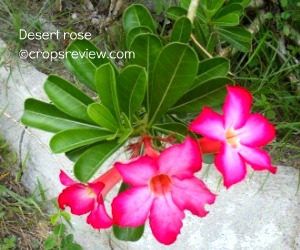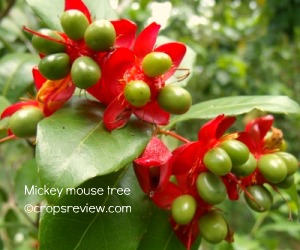Common plant names or common names of plants, also called vernacular names, local names, and country names, are the names used to refer to specific plants as contrasted to scientific names, botanical plant names, or Latin names.
Their usage may be restricted to a small tribe having a unique dialect, a province, a region, or a country.
Others, often in English, are used with wide international recognition, such as rice, coconut, and banana.
Many publications separate the English common names from the vernacular names, for example, Common names: rice (Engl.), palay (Tag.), humay (Ceb.).
The main advantage of using common plant names is the ease of usage and common understanding in certain geographical areas and, conversely, the prevention of confusion among the laymen who do not understand Latin.
Latin names are also difficult to memorize.
For these reasons, some organizations and government agencies are attempting to create a list of official names based on the country’s native or official language.
It will be a great advantage to those who are engaged in disseminating or learning the fundamentals of crop farming and to the agricultural extension workers if they are also familiar with common names.
However, It is impractical, even preposterous, to try to convince the laymen to memorize and use scientific names.
Just imagine this hypothetical scenario:
A farmer of your acquaintance passes in front of your home lot peddling on foot fresh vegetables from his farm. You approach him and, even knowing that there’s none, ask, “Hey Pedro, do you have a Solanum? A Solanum melongena?”
Well. well. well. The likelihood is that you will receive a burst of laughter, and probably also, a pat on the back.
Not me though for that common plant name still remains in this little nut of mine. But that joyous laughter will be unavoidable.
Probably instead, I will add to the No that “But I have a Lagenaria siceraria, some Lycopersicon, and plenty of Ipomoea.
That way you will have the revenge that you deserve and I will have poetic justice too.

Many common plant names actually can cause confusion not only locally but internationally.
Worst, unscrupulous plant traders can easily invent common names for a personal profit with total disregard to the possible injury, financially or otherwise, that it may cause.
How Common Names of Plants Can Mislead
Here is a factual example of how common names of plants can mislead
In the Philippines, ginseng became so popular among men as a medicinal plant, primarily for its purported aphrodisiac property. It was even featured on national television.
The root is harvested from the base of the trunk downward, washed, and inserted into a wide-mouthed bottle with wine or liquor. Some use stems and leaves.
The liquor is consumed as a magical decoction, never mind the taste of rot.
But this ginseng is not the same as that of the world-famous plant which belongs to the genus Panax.
It is actually Jatropha podagrica, also known by the common names Buddha belly plant, gout plant, and bottle plant.
Just like a physic nut (Jatropha curcas), also commonly called “tubang bakod,” “tuba-tuba” and “kasla”, and other plants of the genus Jatropha, all parts of the Buddha belly plant are poisonous when ingested.
Jatropha plants may contain hydrocyanic acid according to Begg and Gaskin (1994).

How Buddha belly plant came to be called ginseng is difficult to establish, but it is believed that it started from ornamental plant nurseries which sell the plant for profit.
Other Examples of Confusing or Misleading Use of Common Plant Names
– Bangkok or Thailand kalachuchi for Adenium obesum (Impala lily or desert rose).
“Kalachuchi” is the Filipino name for Plumiera acutifolia (Temple flower, Graveyard flower, Frangipangi) (Merrill, 1912). “Lily” and “rose” may likewise mislead.
– Money tree for Ochna kirkii (Mickey mouse plant or tree). The common name was used by nurserymen who sold the plant in potted form.
Within a short time, it became popular as a lucky plant, supposedly having a magical charm which promotes financial success to the grower.
– Gensan mango for a plant that is not among the various species under Mangifera but probably Spondias cytherea, a close relative of Spondias purpurea (red mombin, Spanish plum, siniguelas).
Potted plants on sale became a hit.
– Bell pepper and chili or hot pepper belong to the genus Capsicum but black pepper is the common plant name for Piper nigrum.
– Chinese bamboo for Dracaena godseffiana (gold-dust dracaena or spotted dracaena).
D. godseffiana is not a member of the bamboo family but of the Agavaceae. It has very slender stems and leaves with whitish spots (Steiner, 1986).
– Corn (Zea mays) is also called maize. But in England, corn refers to wheat and, in Scotland, rye or barley (herbarium.usu.edu, accessed May 21, 2010).
– Indian ricegrass for Achnatherum hymenoides, but it is not a close relative of either rice or wild rice (herbarium.usu.edu, accessed May 21, 2010)

–Onion (Allium cepa) is known as bawang besar in Brunei and Malaysia and bawang Bombay in Indonesia (scribd.com, accessed Sept. 21, 2010).
But bawang is also the common plant name for garlic (Allium sativum), also known as “ahos”, in the Philippines.
– Traveller’s tree (Ravenala madagascariensis) is also called Traveller’s palm.
But it is neither a tree nor a palm, it only looks like a palm plant. It belongs to the banana family, Musaceae (Steiner, 1986).
– Alagasi (Leucosyke capitellata) has 35 other common plant names in the Philippines (stuartxchange.org, accessed Sept. 20, 2010).
– White waterlily (Nymphaea alba) has 15 different English common names.
Including the common German, French, and Dutch names, it has a total of more than 240 names! (Jenks, 2010; oregonstate.edu, 2010).
Note: The photos here displayed bear captions of the common plant names and/or scientific names of each plant.
You can also hover by resting that cursor arrow above the photo to reveal its international English common name and corresponding scientific name.
It cannot be discounted though that some of the given scientific names mentioned here may have already been replaced, but in such case, it’s not lost or deleted.
It may still exist, though it becomes a synonym (abbreviated “syn.”). Otherwise, it is marked “unaccepted”.
To find if it still remains an “accepted” name, you may refer to the websites “www.theplantlist.org” and “www.itis.gov”.
The herein author warrants that the English common names and the scientific names given for the three photos displayed were accurate as of 2010 when this article was published.
He learned of these and of more than 100 others from picture cyclopedias and from academic authorities at UPLB and memorized the same and their identification for periodic memory checks.
There was no reason or prompting to recheck but now he just did.
The search revealed that Jatropha podagrica is “unresolved” at theplantlist.org but “accepted” at itis.gov.
Moreover, the latter site provides that this scientific name corresponds to a plant with the English common name “goutystalk nettlespurge”.
References
Begg, J. and T. Gaskin. 1994. Jatropha podagrica. Retrieved September 20, 2010, from http://www.inchem.org/documents/pims/plant/jpoc.htm.
Herbarium.usu.edu. Botanical nomenclature. Retrieved May 21, 2010, from http://herbarium.usu.edu/teaching/4420/botnom.htm.
Jenks, A. 2010. Plant nomenclature. Retrieved May 21, 2010, from http://www.hort.purdue.edu/hort/courses/hort217/Nomenclature/description.htm.
Merrill, E.D. 1912. A Flora of Manila. (1976 reprint). Manila: Bu. of Printing. p. 369.
Oregon State University. 2010. Scientific plant names. Retrieved May 21, 2010, from https://oregonstate.edu/dept/ldplants/sci-names.htm.
Scribd.com. Common name: onion Scientific name: Allium cepa. Retrieved September 20, 2010, from http://www.scribd.com/doc/26178138/Common-Name-Onion-Scientific-Name-Allium-Cepa.
Steiner, M.L. 1986. Philippine Ornamental Plants and Their Care. 3rd ed. Las Pinas, Metro Manila: M & L Licudine Ent. 233 p.
Stuartxchange. Plant names- origins of botanical names. Retrieved September 20, 2010 from http://www.stuartxchange.org/PlantNames.html.
Wikipedia. 2010. Common name. Retrieved September 20, 2010, from https://en.wikipedia.org/wiki/Common_name.
